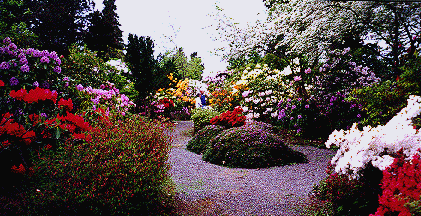
| Since rhododendrons take on many forms it is not difficult to find variety, but it is important to select shapes that complement each other. The 50-year-old r. fastigiatum in the center above make a tight mound and provide an interesting break in the path. They are a focal point the visitor can walk around, and are surrounded by increasingly taller shrubs and trees. |
| Huge rhododendrons can be a backdrop rather than a focal point. They appear even larger when one focuses on an object in the foreground rather than on the plant itself. |
|
 |
|
The most common but still effective attention to form in garden design is arranging plants of increasing height from the near edge to the center or back of a bed. Good design means knowing how tall plants will grow in five or ten or twenty years. A garden is more interesting if the same pattern is not repeated in all beds. Both the height and steepness of the plantngs should be varied. The bed at left lies between a lawn and the perimeter of the property, so it is larger than some. The layers of flowers ascend from waste-high to nearly twenty feet. Six different heights of rhododendrons are used. Other beds begin with r. keleticum that are under a foot high, and some contain tall plants, such as the Beauty of Littleworth above, right up to the path or lawn. |
